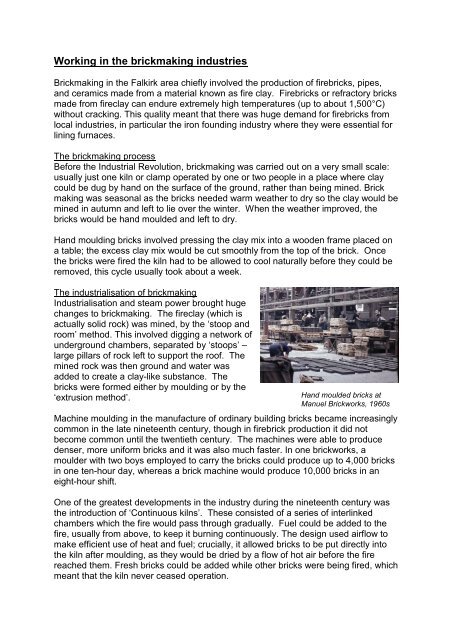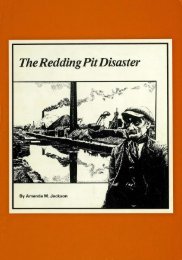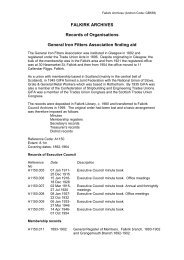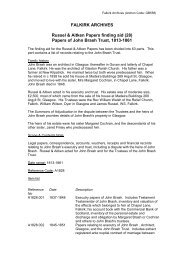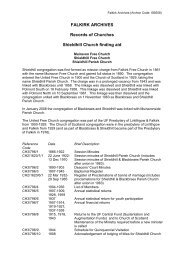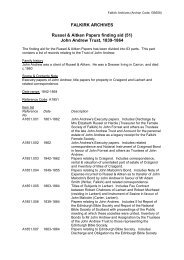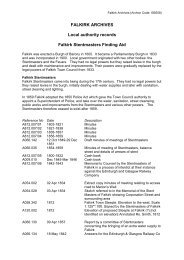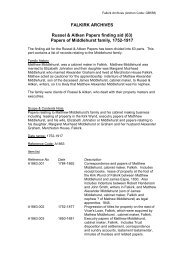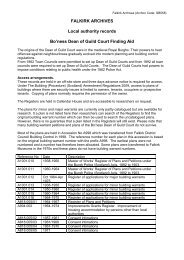Working in the brickmaking industry - Falkirk Community Trust
Working in the brickmaking industry - Falkirk Community Trust
Working in the brickmaking industry - Falkirk Community Trust
You also want an ePaper? Increase the reach of your titles
YUMPU automatically turns print PDFs into web optimized ePapers that Google loves.
<strong>Work<strong>in</strong>g</strong> <strong>in</strong> <strong>the</strong> brickmak<strong>in</strong>g <strong>in</strong>dustries<br />
Brickmak<strong>in</strong>g <strong>in</strong> <strong>the</strong> <strong>Falkirk</strong> area chiefly <strong>in</strong>volved <strong>the</strong> production of firebricks, pipes,<br />
and ceramics made from a material known as fire clay. Firebricks or refractory bricks<br />
made from fireclay can endure extremely high temperatures (up to about 1,500°C)<br />
without crack<strong>in</strong>g. This quality meant that <strong>the</strong>re was huge demand for firebricks from<br />
local <strong>in</strong>dustries, <strong>in</strong> particular <strong>the</strong> iron found<strong>in</strong>g <strong>in</strong>dustry where <strong>the</strong>y were essential for<br />
l<strong>in</strong><strong>in</strong>g furnaces.<br />
The brickmak<strong>in</strong>g process<br />
Before <strong>the</strong> Industrial Revolution, brickmak<strong>in</strong>g was carried out on a very small scale:<br />
usually just one kiln or clamp operated by one or two people <strong>in</strong> a place where clay<br />
could be dug by hand on <strong>the</strong> surface of <strong>the</strong> ground, ra<strong>the</strong>r than be<strong>in</strong>g m<strong>in</strong>ed. Brick<br />
mak<strong>in</strong>g was seasonal as <strong>the</strong> bricks needed warm wea<strong>the</strong>r to dry so <strong>the</strong> clay would be<br />
m<strong>in</strong>ed <strong>in</strong> autumn and left to lie over <strong>the</strong> w<strong>in</strong>ter. When <strong>the</strong> wea<strong>the</strong>r improved, <strong>the</strong><br />
bricks would be hand moulded and left to dry.<br />
Hand mould<strong>in</strong>g bricks <strong>in</strong>volved press<strong>in</strong>g <strong>the</strong> clay mix <strong>in</strong>to a wooden frame placed on<br />
a table; <strong>the</strong> excess clay mix would be cut smoothly from <strong>the</strong> top of <strong>the</strong> brick. Once<br />
<strong>the</strong> bricks were fired <strong>the</strong> kiln had to be allowed to cool naturally before <strong>the</strong>y could be<br />
removed, this cycle usually took about a week.<br />
The <strong>in</strong>dustrialisation of brickmak<strong>in</strong>g<br />
Industrialisation and steam power brought huge<br />
changes to brickmak<strong>in</strong>g. The fireclay (which is<br />
actually solid rock) was m<strong>in</strong>ed, by <strong>the</strong> ‘stoop and<br />
room’ method. This <strong>in</strong>volved digg<strong>in</strong>g a network of<br />
underground chambers, separated by ‘stoops’ –<br />
large pillars of rock left to support <strong>the</strong> roof. The<br />
m<strong>in</strong>ed rock was <strong>the</strong>n ground and water was<br />
added to create a clay-like substance. The<br />
bricks were formed ei<strong>the</strong>r by mould<strong>in</strong>g or by <strong>the</strong><br />
‘extrusion method’.<br />
Hand moulded bricks at<br />
Manuel Brickworks, 1960s<br />
Mach<strong>in</strong>e mould<strong>in</strong>g <strong>in</strong> <strong>the</strong> manufacture of ord<strong>in</strong>ary build<strong>in</strong>g bricks became <strong>in</strong>creas<strong>in</strong>gly<br />
common <strong>in</strong> <strong>the</strong> late n<strong>in</strong>eteenth century, though <strong>in</strong> firebrick production it did not<br />
become common until <strong>the</strong> twentieth century. The mach<strong>in</strong>es were able to produce<br />
denser, more uniform bricks and it was also much faster. In one brickworks, a<br />
moulder with two boys employed to carry <strong>the</strong> bricks could produce up to 4,000 bricks<br />
<strong>in</strong> one ten-hour day, whereas a brick mach<strong>in</strong>e would produce 10,000 bricks <strong>in</strong> an<br />
eight-hour shift.<br />
One of <strong>the</strong> greatest developments <strong>in</strong> <strong>the</strong> <strong>in</strong>dustry dur<strong>in</strong>g <strong>the</strong> n<strong>in</strong>eteenth century was<br />
<strong>the</strong> <strong>in</strong>troduction of ‘Cont<strong>in</strong>uous kilns’. These consisted of a series of <strong>in</strong>terl<strong>in</strong>ked<br />
chambers which <strong>the</strong> fire would pass through gradually. Fuel could be added to <strong>the</strong><br />
fire, usually from above, to keep it burn<strong>in</strong>g cont<strong>in</strong>uously. The design used airflow to<br />
make efficient use of heat and fuel; crucially, it allowed bricks to be put directly <strong>in</strong>to<br />
<strong>the</strong> kiln after mould<strong>in</strong>g, as <strong>the</strong>y would be dried by a flow of hot air before <strong>the</strong> fire<br />
reached <strong>the</strong>m. Fresh bricks could be added while o<strong>the</strong>r bricks were be<strong>in</strong>g fired, which<br />
meant that <strong>the</strong> kiln never ceased operation.
Load<strong>in</strong>g <strong>the</strong> bricks <strong>in</strong>to <strong>the</strong> kiln at<br />
Castlecary Brickworks, 1924<br />
John G Ste<strong>in</strong><br />
In <strong>the</strong> n<strong>in</strong>eteenth century, brickmak<strong>in</strong>g was not<br />
limited to male workers. Women and children as<br />
young as eight were often employed as cheap<br />
labour. As with all <strong>the</strong> heavy <strong>in</strong>dustries, <strong>in</strong>jury and<br />
chronic illness were common consequences of<br />
work<strong>in</strong>g <strong>in</strong> brickmak<strong>in</strong>g. On top of <strong>the</strong> dangers of<br />
heavy mach<strong>in</strong>ery <strong>the</strong> process of crush<strong>in</strong>g and<br />
gr<strong>in</strong>d<strong>in</strong>g <strong>the</strong> clay produced dust which conta<strong>in</strong>ed<br />
high levels of silica. This meant that diseases such<br />
as silicosis and lung cancer were common among<br />
brickmakers.<br />
Brickmak<strong>in</strong>g <strong>in</strong> <strong>Falkirk</strong><br />
The <strong>Falkirk</strong> area had plenty of <strong>the</strong> natural resources needed for <strong>the</strong> brickmak<strong>in</strong>g<br />
<strong>in</strong>dustry. Places such as Bonnybridge, Torwood and Birkhill had seams of fireclay,<br />
which meant that <strong>the</strong> <strong>Falkirk</strong> area specialised <strong>in</strong> <strong>the</strong> production of refractory bricks.<br />
The canals and <strong>the</strong> railway also made <strong>the</strong> transportation of bulky, heavy materials<br />
practical.<br />
The largest brickmak<strong>in</strong>g company <strong>in</strong> <strong>the</strong> <strong>Falkirk</strong> area, John G Ste<strong>in</strong><br />
and Company Ltd, was established <strong>in</strong> 1887 and it eventually became<br />
<strong>the</strong> largest producer of firebricks <strong>in</strong> <strong>the</strong> British Empire. Initially, <strong>the</strong><br />
Milnquarter Works at Bonnybridge produced 30,000 bricks per week,<br />
all made by hand. Early <strong>in</strong> <strong>the</strong> life of <strong>the</strong> Company, John Ste<strong>in</strong> went<br />
<strong>in</strong>to partnership with Mr Cockburn, who owned an iron foundry <strong>in</strong><br />
<strong>Falkirk</strong> and was one of his ma<strong>in</strong> customers. With <strong>the</strong> extra <strong>in</strong>put of<br />
capital, <strong>the</strong> bus<strong>in</strong>ess flourished and <strong>in</strong> 1896 Ste<strong>in</strong> was able to buy out<br />
Cockburn’s share. That year Ste<strong>in</strong> ambitiously <strong>in</strong>troduced a<br />
brickmak<strong>in</strong>g mach<strong>in</strong>e to his newly established Anchor Works. He<br />
hoped it would produce 10,000 bricks per shift but this mach<strong>in</strong>e only reached its full<br />
capacity for production when Ste<strong>in</strong> transferred it to <strong>the</strong> Milnquarter Works where <strong>the</strong><br />
clay was more malleable. Ste<strong>in</strong> cont<strong>in</strong>ued to expand and opened <strong>the</strong> Castlecary<br />
Works <strong>in</strong> 1899 and <strong>the</strong> Manuel Works, near Whitecross, <strong>in</strong> 1928. By 1932, he was<br />
produc<strong>in</strong>g 1 million refractory bricks every week. Milnquarter Works closed <strong>in</strong> <strong>the</strong><br />
1960s and <strong>the</strong> Company was taken over <strong>in</strong> 1971. Manuel Works cont<strong>in</strong>ued<br />
operations under <strong>the</strong> new company until it was closed <strong>in</strong> 2001.<br />
Sources<br />
You can f<strong>in</strong>d out more about <strong>Falkirk</strong>’s brickmak<strong>in</strong>g <strong>in</strong>dustry from a variety of primary<br />
and secondary sources. The history of John G Ste<strong>in</strong> and Company Ltd is described<br />
<strong>in</strong> detail <strong>in</strong> Ste<strong>in</strong> of Bonnybridge by Kenneth W. Sanderson. You can f<strong>in</strong>d out about<br />
photographs, objects and archives held by <strong>Falkirk</strong> Archives & Museums by search<strong>in</strong>g<br />
our Collections Browser on our website<br />
http://www.falkirkcommunitytrust.org/heritage.


